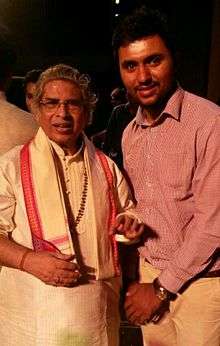Debu Chaudhuri
| Pandit Devabrata (Debu) Chaudhuri | |
|---|---|
 Pandit Devabrata (Debu) Chaudhuri | |
| Born |
Devabrata (Debu) Chaudhuri 1935 Mymensing (Bangladesh) |
| Nationality | Indian |
| Education | Senia Gharana |
| Known for | Music Sitar |
| Notable work | Published 6 Books, Composed 8 ragas |
| Spouse(s) | Manjushree Chaudhuri |
| Awards | Padmabhushan, Padmashree |
| Website |
www |
| Patron(s) | Ustad Mushtaq Ali Khan |
Pandit Devabrata (Debu) Chaudhuri is a Sitarist and a teacher. He is the winner of the Padmabhushan and Padmashree awards. He is the writer of six books, composer of eight new ragas and numerous musical compositions. From 1963 he has appeared in numerous radio broadcasts, and he is a disciple of Mushtaq Ali Khan.[1] He is considered a leading Sitarist of Post War era.[2] He is regarded as one of the leading proponents of Senia Style (or Gharana).[3] He is the former Dean and Head, Faculty of Music, University of Delhi.[4] His music is noted for its sweet sinking ringing tone.[5] He currently stays with his son, daughter-in law and niece at Chittaranjan Park, New Delhi
Birth
Pt. Chaudhuri was born in 1935 in Mymensing (now in Bangladesh).[6] He started playing the Sitar from four years of age. His first broadcast was at the age of eighteen at the All India Radio in 1953.
Training
He received his education in the University of Calcutta. He joined Delhi University as a reader from 1971 to 1982 and was the Dean and Head of Music Department from 1985 to 1988. He has served as a visiting professor at Maharishi International University (now called Maharishi University of Management), Iowa from 1991 to 1994.[7] He received his training in Sitar under late Panchu Gopal datta and Ustad Mustaq Ali Khan.[8]
Music
He started playing the Sitar from four years of age. His first broadcast was at the age of eighteen at the All India Radio in 1953.[9] He created 8 new Ragas viz. Bisweswari, Palas-Sarang, Anuranjani, Ashiqui Lalit, Swanandeswari, Kalyani Bilawal, Shivamanjari and Prabhati Manjari (in memory of his wife Manju). He has authored three books on Indian Music namely ‘Sitar and It's Techniques’, ‘Music of India’ and ‘On Indian Music’. He has recorded 24 CDs for 24 hours of the day in USA.[10]
Style
He is considered a leading proponent of playing the repeated articulation of the pedal tone (also called the ‘’’Jod’’’) with the tonic pitch of the second string (also called the ‘’’Jodi’’’) string, by pulling the string across the fret that is allowed to die out before the basic alternation stroking is continued.He is considered one of the greatest sitar player of the era with Ustad Vilayat Khan, Ravi Shankar and Nikhil Banerjee .[2] He is also unique in using the 17 fret sitar while most musicians use the 19 fret sitar.[11]
Contributions
UMAK
In April 2010 he started the UMAK (Ustad Mushtaq Ali Khan) Center for culture in memory of his ‘’guru’’ Ustad Mushtaq Ali Khan.[12]
References
- ↑ India today. Thomson Living Media India Ltd. 2008. p. 78. Retrieved 17 March 2012.
- 1 2 James McConnachie; Rough Guides (Firm) (2000). World music: the rough guide. Rough Guides. p. 72. ISBN 978-1-85828-636-5. Retrieved 17 March 2012.
- ↑ John Shepherd (27 February 2003). Continuum encyclopedia of popular music of the world: VolumeII: Performance and production. Continuum International Publishing Group. p. 446. ISBN 978-0-8264-6322-7. Retrieved 17 March 2012.
- ↑ Dilip Ranjan Barthakur (2003). The music and musical instruments of North Eastern India. Mittal Publications. p. 5. ISBN 978-81-7099-881-5. Retrieved 17 March 2012.
- ↑ The beat. Bongo Productions. 1992. p. 53. Retrieved 17 March 2012.
- ↑ Sruti. P.N. Sundaresan. 1 January 1998. p. 17. Retrieved 17 March 2012.
- ↑ Ravi Bhushan (2003). Reference India: A-F. Rifacimento International. p. 256. Retrieved 17 March 2012.
- ↑ Link. United India Periodicals. 1979. p. 82. Retrieved 17 March 2012.
- ↑ Subhra Mazumdar (2010). "Tied to His Strings". The Open Magazine. Retrieved 2012-03-19.
- ↑ Abhay (2008). "Pandit Debu Chaudhuri". Retrieved 2012-03-19.
- ↑ RANEE KUMAR (2005). "Classicist to the core". the Hindu. Retrieved 2012-03-19.
- ↑ MANJARI SINHA. "His master's voice". The Hindu. Retrieved 2012-03-19.